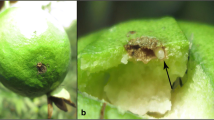Abstract
I tested experimentally whether the presence of colorful plastic ovals (simulating foliar “flags”) attached to infructescences of Rhus glabra increase fruit removal by birds in a forest-oldfield border. I used a factorial experimental design testing for the effect of size (small or large) and color (yellow or red) of the flags. There was also a control, without flags. Large red flags increased the percent of fruits removed from the panicles, but yellow and small flags had no effect. My results give partial support to Stiles (1982) hypothesis that early color change of leaves close to the fruits in some plants may serve as visual signals that attract frugivorous birds and enhances seed dispersal.
Similar content being viewed by others
References
Benson WW, Brown KS, Gilbert LE (1975) Coevolution of plants and herbivores: passion flower butterflies. Evolution 29: 659–680
Brinkam KA (1974) Rhus L., Sumac. In: Forest Service (ed), Seeds of woody plants in the United States (Agriculture Handbook 450), USDA, Washington, pp 367–369
Futuyma DJ, Slatkin M (1983) Coevolution. Sinauer Sunderland, Massachusetts
Greig-Smith PW (1986) Bicolored fruit displays and frugivorous birds: the importance of fruit quality to dispensers and seed predators. Am Nat 127: 246–251
Janson CH (1987) Bird consumption of bicolored fruit displays. Am Nat 130: 788–792
Martin AC, Zim HS, Nelson AL (1951) American wildlife and plants. A guide to wildlife food habits. Dover Press, NY
Mosquin LW (1971) Competition for pollinators as a stimulus for evolution of flowering time. Oikos 22:398–402
Rhoades DF (1979) Evolution of plant chemical defense against herbivores. In: Rosenthal GA, Jansen DH (eds) Herbivores: their interaction with secondary plant metabolites. Academic Press, NY, pp 4–55
Stiles EW (1980) Patterns of fruit presentation and seed dispersal in bird-disseminated woody plants in the eastern deciduous forest. Am Nat 116:670–688
Stiles EW (1982) Fruit flags: two hypotheses. Am Nat 120:500–509
Strong OR, Lawton JH, Southwood R, (1984) Insects on plants. Community patterns and mechanisms. Harvard University Press, Cambridge, Massachusetts
Wheelwright NT, Janson CH (1985) Colors of fruit displays of birddispersed plants in two tropical forests. Am Nat 126:777–799
Willson MF, Hoppes WG (1986) Foliar “flags” for avian frugivore: signal or serendipity? In: Estrada A, Fleming TH (eds) Frugivore and seed dispersal. Junk, Boston, pp 55–69
Author information
Authors and Affiliations
Rights and permissions
About this article
Cite this article
Facelli, J.M. Experimental evaluation of the foliar flag hypothesis using fruits of Rhus glabra (L.). Oecologia 93, 70–72 (1993). https://doi.org/10.1007/BF00321193
Received:
Accepted:
Issue Date:
DOI: https://doi.org/10.1007/BF00321193




